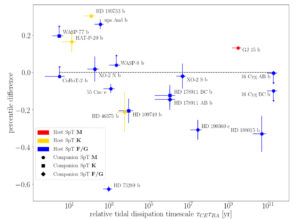Paper on tidal star-planet interactions

My PhD student Nikoleta Ilic has published a project we have been working on for the past two years: the identification of tidal star-planet interaction in a sample of planet-hosting stars. The tidal interaction leads to a spin-up of the host stars, which we identified through comparisons with co-eval companion stars in wide orbits around the star-planet systems.
The paper was also featured in a joint press release of the AIP and the Harvard-Smithsonian Center for Astrophysics: https://chandra.harvard.edu/press/22_releases/press_110222.html
Ilic, N. search by orcid ; Poppenhaeger, K. search by orcid ; Hosseini, S. Marzieh: “Tidal star-planet interaction and its observed impact on stellar activity in planet-hosting wide binary systems”
Tidal interaction between an exoplanet and its host star is a possible pathway to transfer angular momentum between the planetary orbit and the stellar spin. In cases where the planetary orbital period is shorter than the stellar rotation period, this may lead to angular momentum being transferred into the star’s rotation, possibly counteracting the intrinsic stellar spin-down induced by magnetic braking. Observationally, detecting altered rotational states of single, cool field stars is challenging, as precise ages for such stars are rarely available. Here we present an empirical investigation of the rotation and magnetic activity of a sample of planet-hosting stars that are accompanied by wide stellar companions. Without needing knowledge about the absolute ages of the stars, we test for relative differences in activity and rotation of the planet hosts and their co-eval companions, using X-ray observations to measure the stellar activity levels. Employing three different tidal interaction models, we find that host stars with planets that are expected to tidally interact display elevated activity levels compared to their companion stars. We also find that those activity levels agree with the observed rotational periods for the host stars along the usual rotation-activity relationships, implying that the effect is indeed caused by a tidal interaction and not a purely magnetic interaction that would be expected to affect the stellar activity, but not necessarily the rotation. We conclude that massive, close-in planets have an impact on the stellar rotational evolution, while the smaller, more distant planets do not have a significant influence.
Monthly Notices of the Royal Astronomical Society, Volume 513, Issue 3, pp.4380-4404 (2022), https://ui.adsabs.harvard.edu/abs/2022MNRAS.513.4380I/abstract